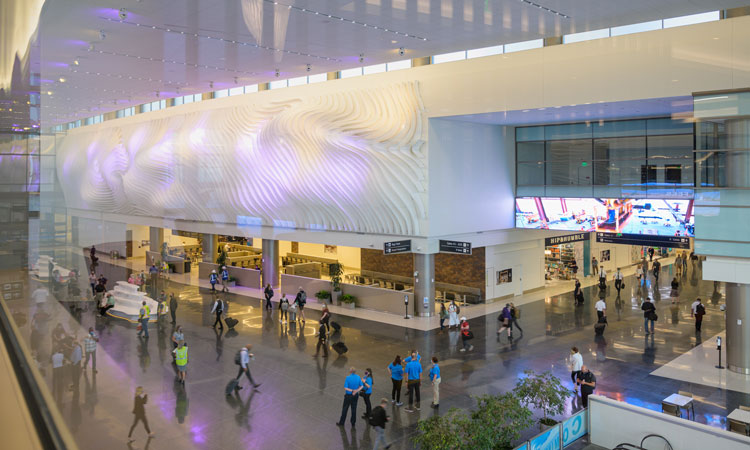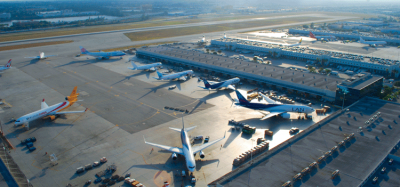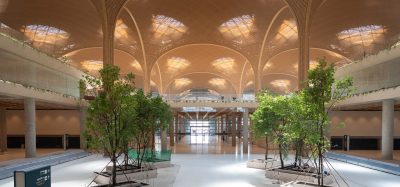The New Salt Lake City Airport takes flight
- Like
- Digg
- Del
- Tumblr
- VKontakte
- Buffer
- Love This
- Odnoklassniki
- Meneame
- Blogger
- Amazon
- Yahoo Mail
- Gmail
- AOL
- Newsvine
- HackerNews
- Evernote
- MySpace
- Mail.ru
- Viadeo
- Line
- Comments
- Yummly
- SMS
- Viber
- Telegram
- Subscribe
- Skype
- Facebook Messenger
- Kakao
- LiveJournal
- Yammer
- Edgar
- Fintel
- Mix
- Instapaper
- Copy Link
Posted: 17 December 2020 | Bill Wyatt | No comments yet
In an interview for International Airport Review, Bill Wyatt, SLCDA’s Executive Director, explains how the new Salt Lake City International Airport will provide passengers with an entirely new experience, from curb to gate, compared to the previous airport.


On 15 September 2020, the Salt Lake City Department of Airports (SLCDA) turned the key and opened the first phase of The New SLC Airport. As the lights dimmed on the existing airport, the lights brightened on a new parking garage, gateway center, central terminal and Concourse A-west. Delta Air Lines currently occupies the 25 gates in Concourse A-west, including six international gates. Six weeks later, Concourse B opened, with 21 gates for the six additional airlines operating out of SLC.
“The opening day had been years in the making,” said Bill. “To say we were excited is an understatement. After six years of construction and many more years of planning, we were proud to open the first new U.S. hub airport in the 21st century.”
The need to build a new SLC Airport became apparent as passenger numbers grew and facilities became outdated. Prior to the pandemic, SLC recorded more than 26 million passengers in 2019, in an airport that was built for only 10 million passengers.
On 15 September 2020, the Salt Lake City Department of Airports (SLCDA) turned the key and opened the first phase of The New SLC Airport. As the lights dimmed on the existing airport, the lights brightened on a new parking garage, gateway center, central terminal and Concourse A-west. Delta Air Lines currently occupies the 25 gates in Concourse A-west, including six international gates. Six weeks later, Concourse B opened, with 21 gates for the six additional airlines operating out of SLC.
“The opening day had been years in the making,” said Bill. “To say we were excited is an understatement. After six years of construction and many more years of planning, we were proud to open the first new U.S. hub airport in the 21st century.”
The need to build a new SLC Airport became apparent as passenger numbers grew and facilities became outdated. Prior to the pandemic, SLC recorded more than 26 million passengers in 2019, in an airport that was built for only 10 million passengers.
“The advantages of building an entirely new airport is that the architects were able to design for the future to create a more efficient and more sustainable facility,” explained Bill. “The new concourses are designed in a parallel configuration – compared to the current pier layout – which will eliminate aircraft bottlenecks and idling, so airlines are able to get their planes to the gate and back in the air quicker.”
SLCDA also built the new facilities with LEED Gold Certification from the U.S. Green Building Council in mind. Bill explained: “The airport achieved this certification through a variety of ways, such as converting all airline ground service equipment to electric. Plus, the use of natural light will also help to achieve the airport’s energy goals.”
Additional highlights of the $4.1 billion airport include the following:
- A two-level roadway system with an elevated road designated for departures
- A parking garage with 3,600 parking stalls and a camera-based sensor system that uses lights to indicate where open spots are located. Plus, 56 places to charge electronic vehicles
- The Gateway, which houses car rental counters and quick-check airline ticket counters
- Sixteen security screening lanes with automatic return bins to aid in touchless travel
- Forty-five concessions: 21 restaurants and 24 stores in the terminal and Concourse A-west – all with street pricing
- Electronic plug-ins at each seat and in open seating areas throughout the airport
- Seven miles of luggage conveyor belts to accommodate oversized bags, such as skis, snowboards, bike boxes and golf clubs
- Aircraft gates that employ the SAFEGATE Aircraft Docking System to provide pilots with active guidance to support safe, efficient and precise automated aircraft parking during all operating conditions
- Twenty-four restrooms with deep bathroom stalls and unique Whimsy Wall artwork. Many restrooms also have private lactation rooms. Passengers are never more than 150 feet away from the next restroom facility
- The Greeting Room, a large area that can accommodate 300 to 400 individuals where friends, families and others can wait to pick up passengers once physical distancing measures are no longer in place
- Large-scale art installations by artist Gordon Huether, such as The Canyon, The Falls, The Plates and Benches, which represent Utah’s natural beauty and provide a sense of place.
The second act: The opening of Concourse B
With the debut of Concourse B on 27 October 2020, all airlines serving SLC began operating out of entirely new facilities. Concourse B houses Alaska, American, Delta, Frontier, JetBlue, Southwest and United. This completes phase I of the project.
Concourse B will initially have three new restaurants (Gourmandise: Euro Diner and Bakery, Uinta Brewing Company and Wasatch Brew Pub) and five new shops (@ease, InMotion, Liberty Park Market, Hip & Humble, Maverik and The Salt Lake Tribune). Additional restaurants and shops will follow as passenger numbers increase, including Pick Up Stix, Smashburger, Briggs & Riley, Utah! and XpresSpa.
Prior to the pandemic, SLC recorded more than 26 million passengers in 2019, in an airport that was built for only 10 million passengers”
“A 990ft-long tunnel – originally built in 2004 – connects concourses A and B,” explained Bill. “Passengers have been delighted to see the four seasons of Utah represented through art murals as they make their way through the tunnel. Salt Lake City-based artist Traci O’Very Covey painted summer and fall, while Texas-based artist DAAS painted winter and spring.”
Additional facts about Concourse B:
- The 21 gates have been allocated as follows: Alaska-1, American-2, Delta-7, Frontier-1, JetBlue-1, Southwest-4 and United-2. In addition, there are three common-use or city gates that will be used by various airlines as needed
- Gates B21 and B24 will serve as access points to a hard-stand operation for primarily regional aircraft
- Eight restrooms (seven with private lactation rooms) with deep bathroom stalls and unique Whimsy Wall artwork
- Ability to add eight gates in a second phase, and 15 gates in a third phase.
With Phase I of The New SLC now complete, demolition is underway on the previous airport structure in preparation for the next phase. Bill explained: “Phase II will include the build out of Concourse A to the east and construction of the concrete portion of a permanent tunnel to transport passengers between concourses A and B. This is expected to be completed by late 2024.”
The New SLC International Airport will provide passengers with an entirely new experience compared to the previous airport, from curb to gate.
From airfield to airport: SLC celebrates centennial anniversary
On a chilly December day in 1920, a small group of dignitaries and a hardy crowd of several hundred onlookers gathered on a windswept, snow-covered plain near the Great Salt Lake. While the flat and sparsely vegetated landscape, several miles out from downtown Salt Lake City, may have seemed an incongruous venue for a gathering, it was, in fact, perfectly suited to its purpose: The dedication of Salt Lake City’s first permanent airplane landing field.
Fast forward 100 years. Today, the airfield, once known at Woodward Field, is a thriving large-hub airport that is the 23rd busiest in North America and 85th busiest in the world. Pre-pandemic, more than 370 flights departed daily to 100 non-stop destinations. On 21 December 2020, the Salt Lake City Department of Airports will be celebrating its centenary out of a brand-new airport with the placement of a time capsule, the release of an airport history book and screening of a documentary that follows the building of the new SLC.


Issue
Related topics
Related airports
Related airlines
Alaska Airlines, American Airlines, Delta Air Lines, Frontier Airlines, JetBlue, Southwest Airlines, United Airlines
Related organisations
Salt Lake City Department of Airports, U.S. Green Building Council (USGBC)

















